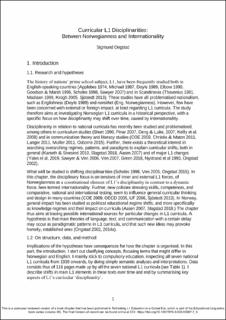| dc.contributor.author | Ongstad, Sigmund | |
| dc.coverage.spatial | Norway | en_US |
| dc.date.accessioned | 2021-09-10T11:27:02Z | |
| dc.date.available | 2021-09-10T11:27:02Z | |
| dc.date.created | 2021-01-19T13:53:24Z | |
| dc.date.issued | 2020-11-25 | |
| dc.identifier.isbn | 978-3-030-55997-7 | |
| dc.identifier.isbn | 978-3-030-55996-0 | |
| dc.identifier.issn | 1572-0292 | |
| dc.identifier.issn | 2215-1656 | |
| dc.identifier.uri | https://hdl.handle.net/11250/2775220 | |
| dc.description.abstract | The chapter explores how international impulses may have affected national L1 curricula in Norway from 1939 to 2020. It compares the descriptions of aims and content in seven curricula chronologically, using content analysis. One eye is on changes within these elements of the subject: the other is on disciplinarity. The hypothesis that the disciplinarity of this L1 subject is at risk, based on the assumption of a clash between national and international forces, termed Norwegianness and internationality. From the 1930s to the 1980s, L1 curricula are dominated, in different periods, by formalism, semanticism, and functionalism. In the 1990s, L1 opened up as communication in general, rather than focusing on ‘language and literature’. Later trends are less clear. Two kinds of international forces are traced, disciplinary and political. While disciplinary ones were strong in the first 50 years, political forces have had more impact since. Further, the chapter draws on other researchers’ critical studies of the impact of international policies, discussing whether political regimes are in conflict with disciplinary paradigms. It is concluded that politics has taken control of curricula as an educational genre, while L1 disciplinarities have had to adjust to a strongly homogenised design. This creates polarised tensions between competence-oriented verbs and disciplinary-oriented nouns in the curricula, hence side-lining the question of students’ Bildung. A further conclusion is that curricular L1 disciplinarities in Norway have moved from Norwegianness toward internationality. | en_US |
| dc.language.iso | eng | en_US |
| dc.publisher | Springer | en_US |
| dc.relation.ispartof | Rethinking L1 Education in a Global Era | |
| dc.relation.ispartofseries | Educational Linguistics;Volume 48 | |
| dc.rights | This is a post-peer reviewed version of a book chapter that has been published in Rethinking L1 Education in a Global Era, which is part of the Educational Linguistics book series (volume 48). The final Version-of-record can be found online at DOI: https://doi.org/10.1007/978-3-030-55997-7_5 | |
| dc.subject | Norskdidaktikk | en_US |
| dc.subject | Mother tongue didactics | en_US |
| dc.subject | Disciplinarities | en_US |
| dc.subject | Internationality | en_US |
| dc.subject | Norwegianness | en_US |
| dc.subject | L1-curricula | en_US |
| dc.subject | Bildung | en_US |
| dc.subject | L1 education | en_US |
| dc.title | Curricular L1 Disciplinarities: Between Norwegianness and Internationality | en_US |
| dc.type | Chapter | en_US |
| dc.type | Peer reviewed | en_US |
| dc.description.version | acceptedVersion | en_US |
| dc.rights.holder | © Springer Nature Switzerland AG 2020 | en_US |
| cristin.ispublished | true | |
| cristin.fulltext | postprint | |
| dc.identifier.doi | https://doi.org/10.1007/978-3-030-55997-7_5 | |
| dc.identifier.cristin | 1874414 | |
| dc.source.journal | Educational Linguistics | en_US |
| dc.source.volume | 48 | en_US |
| dc.source.pagenumber | 83-112 | en_US |
| dc.subject.nsi | VDP::Fagdidaktikk: 283 | en_US |
| dc.subject.nsi | VDP::Subject didactics: 283 | en_US |
